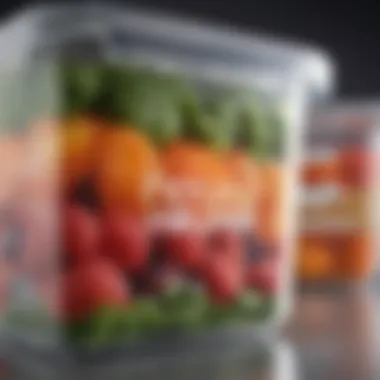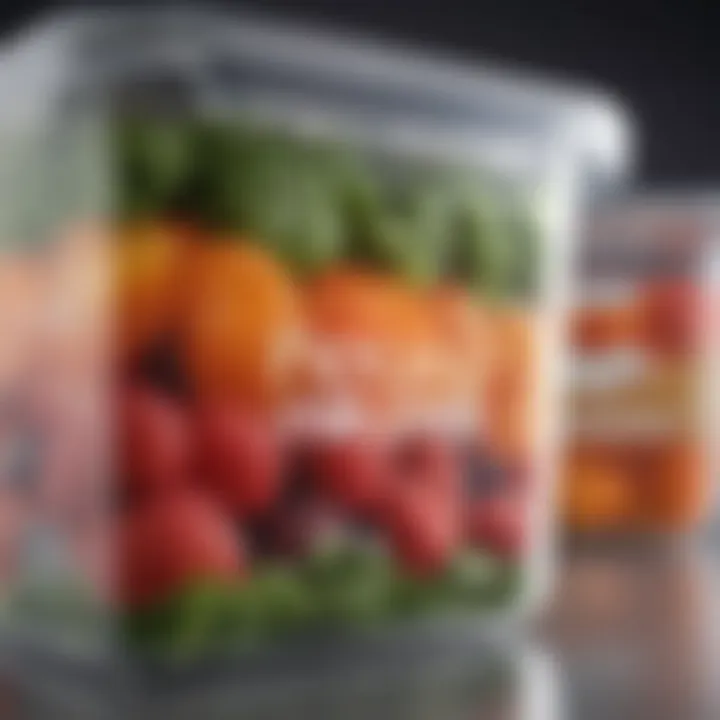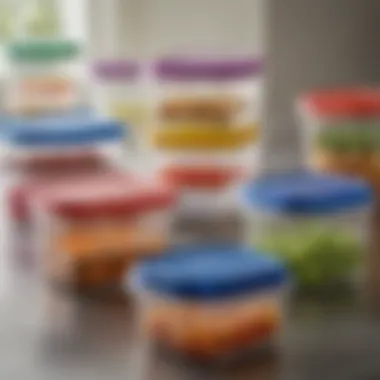The Ultimate Guide to Food Containers for Refrigerators


Intro
In the realm of meal preparation and food storage, refrigerator food containers play an essential role in ensuring food stays fresh and organized. This guide explores various types of containers, their materials, and how they can enhance meal prep efforts for the modern cook. By understanding different features, benefits, and potential drawbacks of each type, the reader can make informed choices. This knowledge is crucial, especially for busy individuals and families looking to streamline their cooking processes and reduce food waste.
Refrigerator food containers are not just about organization; they are also pivotal for food preservation. Different materials, sizes, and shapes serve unique purposes. Glass containers are known for their durability and non-reactivity, while plastic containers offer lightweight convenience. Whether you are packing leftovers, prepping meals for the week, or storing ingredients safely, selecting the right container can profoundly impact the freshness and accessibility of food.
Throughout this guide, you will learn about effective storage techniques and best practices for maintaining food freshness. Additionally, insights into recipes that pair well with organizing your refrigerator will be shared. Each section will present practical knowledge tailored to meet modern cooking needs, emphasizing convenience without compromising quality.
Understanding these crucial aspects prepares you to make better decisions for your kitchen's efficiency and can lead to a more enjoyable cooking experience. The journey through the diverse world of refrigerator food containers begins with a focus on practical insights aimed at elevating your day-to-day culinary tasks.
Intro to Refrigerator Food Containers
The effectiveness of refrigerator food containers cannot be overstated. In a time when time is a rare commodity and food waste is a growing concern, these containers play a vital role in maintaining freshness and organization. As home cooks, food lovers, and busy families look for ways to optimize their meal prep, understanding the varied offerings of food containers becomes essential.
Good food storage systems can help extend shelf life. By using appropriate containers, one can minimize spoilage, retain taste, and preserve nutrients. Furthermore, they allow efficient organization in a refrigerator, making ingredients easily accessible.
Importance of Food Storage
Food storage is crucial for several reasons. First, it directly impacts health. Foods that are not stored properly can become breeding grounds for bacteria, leading to foodborne illnesses. Containing food in suitable materials minimizes exposure to air and moisture, essential factors in preservation. Second, proper storage reduces waste. With rising food prices, every penny counts. By employing the right containers, one can consume what they buy and decrease the amount thrown away.
Additionally, effective food storage promotes variety in meals. Having neatly stored leftovers and prepped ingredients encourages experimentation in cooking. It allows individuals to make combinations or repurpose ingredients, paving the way for creativity in the kitchen.
Lastly, a well-organized refrigerator decreases preparation time. Quickly locating needed ingredients enhances the cooking experience and can make meal preparation smoother and more efficient.
Common Challenges in Food Preservation
Food preservation comes with specific challenges. One major issue is moisture control. Excess moisture can lead to spoilage and mold growth, particularly in fruits and vegetables. For instance, lettuce may wilt if not stored adequately.
Another challenge is the transfer of odors. Some foods emit strong smells that can permeate into other items in the fridge, ruining their taste. Proper sealing in suitable containers can help mitigate this.
Temperature fluctuations in the refrigerator also present a problem. Opening the door frequently can compromise food storage. Utilizing clear containers helps in monitoring the stock without prolonged exposure.
"Understanding the nuances of food storage is akin to mastering a culinary art. It is not just about food; it is about appreciation for quality and sustainability."
Lastly, finding storage solutions that do not take up excessive space is important. Stackable containers or those designed for small compartments can help maintain order while maximizing available space.
Types of Refrigerator Food Containers
Refrigerator food containers play a crucial role in preserving food quality and safety. They help maintain freshness, prevent contamination, and optimize available space. The right type of container can also simplify meal preparation and enhance organization, allowing users to find what they need more easily.
Plastic Containers
Types of Plastic
Plastic containers come in various types, each serving distinct purposes. Common plastics include polyethylene, polypropylene, and polycarbonate. Polypropylene is popular for food storage due to its resistance to heat and chemicals, making it suitable for storing a variety of food items. The unique feature of plastic containers is their lightweight nature, which makes handling easier. However, some plastics may contain harmful chemicals like BPA, which lead to health concerns.
Pros and Cons
Plastic containers offer many benefits. They are usually cost-effective, durable, and versatile. However, certain plastic containers can absorb odors, and some are not microwave-safe. Also, not all plastics are suitable for long-term storage as they can warp over time. Thus, it's essential to choose BPA-free options for health considerations.
Glass Containers
Types of Glass
Glass containers are often favored for their non-reactive nature, which means they do not leach chemicals into food. Types of glass used include borosilicate glass and tempered glass. Borosilicate glass is resistant to thermal shock, making it great for transitioning from fridge to oven. A key characteristic of glass containers is their transparency, which allows for easy visibility of contents. This can prevent food waste by making it easier to track what is stored.
Advantages and Disadvantages
The primary advantage of glass containers is their ability to keep food fresh without any risk of chemical leaching. They are microwave and dishwasher safe, lending to their appeal. However, they can be heavy and more fragile than plastic options. Care must be taken to avoid breaks or cracks during handling or washing.


Silicone Food Containers
Benefits of Silicone
Silicone containers are becoming increasingly popular due to their flexibility and durability. They are often collapsible, making them an excellent choice for space-efficient storage. A significant benefit is that silicone is safe for the microwave, oven, and dishwasher, making it versatile for various cooking needs. Unlike plastics, silicone does not retain odors or stains, which enhances its usability in the kitchen.
Limitations
Despite their many benefits, silicone containers do have some limitations. They are generally more expensive than plastic options and may not provide the same rigidity, which some users prefer for stacking purposes. Additionally, not all silicone is created equal; higher quality silicone can be more expensive.
Stainless Steel Containers
Durability and Longevity
Stainless steel containers are known for their durability and resistance to corrosion. These containers are excellent for both refrigeration and transport. One of the key characteristics of stainless steel is its strength; it does not chip or break like glass, enhancing its appeal for those with busy lifestyles. Stainless steel also does not retain flavors or odors from previously stored food.
Environmental Impact
Choosing stainless steel has positive environmental implications. Stainless steel is recyclable and can be reused over many years, reducing overall waste. However, production processes can involve significant energy use. In light of this, investing in high-quality stainless containers contributes to sustainable living through longevity.
Material Considerations
Choosing the right materials for refrigerator food containers is not merely a matter of preference. The materials impact food safety, environmental sustainability, and overall functionality. Understanding these factors allows users to make informed decisions that align with their values and lifestyle. As food preservation and safety are paramount, the materials used can also affect how well your food lasts in the fridge.
BPA-Free Options
BPA, or bisphenol A, is a chemical often found in certain plastics. It has raised health concerns due to its potential to leach into food items, especially when containers are used in heating or contain acidic foods. For this reason, BPA-free options have gained traction in the market. These containers are generally considered safer for daily use. They are made with alternative materials, reducing the risk of chemical exposure.
When selecting BPA-free containers, look for those clearly marked as such. Many companies today provide transparent labeling that helps consumers identify safe choices. The effectiveness and safety of BPA-free plastic alternatives continue to be evaluated, but many people prefer them over traditional options. Common materials in BPA-free containers include polyethylene and polypropylene.
Eco-Friendly Materials
As awareness of environmental issues rises, eco-friendly materials are becoming more popular for refrigerator food containers. These materials are not only safe for food storage, but they also minimize environmental impact. Common eco-friendly options include glass, stainless steel, and biodegradable plastics.
Glass containers are a prime example of eco-friendly choices. They are reusable, recyclable, and do not release harmful chemicals. Their durability makes them a wise investment. Stainless steel is another option, offering longevity and resistance to staining or odors.
Biodegradable plastics are recent innovations in the market. They decompose more swiftly than conventional plastics, helping to reduce landfill waste. However, they may not be as widely available and their performance can vary.
Using eco-friendly materials for food storage promotes better health for individuals and the planet. Choosing wisely can encourage sustainable practices in food preservation.
In summary, material considerations go beyond mere function. They encompass safety, environmental impact, and usability. Understanding the benefits and drawbacks of BPA-free and eco-friendly materials can aid in selecting the right containers for your refrigerator.
Features to Consider
When choosing refrigerator food containers, several features stand out as crucial for effective food storage and preservation. A well-selected container not only preserves the food but also enhances overall organization and convenience. This section highlights key elements like airtight seals, safety in microwaves and ovens, and stackability, each providing specific benefits that improve user experience while maintaining food quality.
Airtight Seals
Airtight seals are perhaps one of the most vital features in food containers. Their primary role is to prevent air and moisture from entering, factors that can lead to spoilage. By creating a barrier, these seals help prolong the freshness of food items like fruits, vegetables, or meats. In a refrigerator, where temperature fluctuations can occur, having airtight seals mitigates the risk of stale or contaminated food.
Consider the benefits of a container with an airtight seal:
- Freshness: Foods remain crisp and flavorful.
- Odor Prevention: Strong smells from one food do not permeate others.
- Waste Reduction: Less spoilage means savings on groceries.
Choosing a container with a reliable airtight seal ensures that your meals are not only preserved but also served up in the best possible state.
Microwave and Oven Safety
Microwave and oven safety is another critical consideration for food containers. In the fast-paced environment of meal preparation, flexibility in heating food is essential. Containers that are safe for both microwaves and ovens offer significant advantages.
When selecting these containers, look for details like:


- Material Composition: Use materials like glass or certain plastics that are designed to withstand high temperatures.
- Specific Product Labels: Check for labels that indicate suitability for microwave or oven use.
Using appropriate containers reduces the risk of melting or chemical leaching, which can compromise health. Additionally, having the ability to switch directly from refrigeration to cooking helps streamline meal preparation, saving time in the kitchen.
Stackability and Storage
In any kitchen, space is often at a premium, making stackability a feature of great importance. Containers designed to stack effectively can optimize refrigerator space, while also allowing for efficient organization of food items.
Key points to evaluate for stackability include:
- Design: Look for uniform shapes that fit neatly without wasting space.
- Width and Height: Consider containers that are low and broad, as they often stack better.
By improving the organization of your refrigerator with stackable containers, busy individuals can easily find and access their food, reducing meal prep time and stress. This not only enhances the cooking experience but also contributes to less food waste and more thoughtful consumption.
"A well-organized refrigerator with optimal food containers can save time and reduce food waste, enhancing both meal prep efficiency and culinary enjoyment."
In summary, paying attention to features like airtight seals, material safety for microwaving and baking, and stackability can significantly influence your food storage strategies, delivering freshness, health, and organization.
Best Practices for Organizing Containers
Organizing refrigerator food containers is crucial for maintaining food freshness and optimizing space. Effective organization enhances efficiency in meal preparation and minimizes food waste. By understanding best practices in organizing containers, one can streamline the entire cooking and storage process. This results in not only better food preservation but also a more enjoyable cooking environment.
Labeling Systems
A robust labeling system is essential for any well-organized refrigerator. Labels help in identifying different food items quickly and easily. This prevents confusion, especially when multiple similar containers are used. Here are some labeling benefits:
- Clear Identification: Labels allow you to see at a glance what is inside each container. This is particularly helpful when the food is not in its original packaging.
- Date Tracking: Including preparation or expiration dates on labels ensures that older items are used first. This contributes to reducing food waste.
- Custom Labels: Use different colors or symbols for various categories such as leftovers, fresh produce, or sauces to enhance visibility and organization.
Labeling can simply be done using adhesive labels or personalized tags. A simple format could include the food name, date, and any specific notes about the item.
Optimal Arrangements in the Refrigerator
The arrangement of containers in the refrigerator plays a significant role in maintaining food quality and ensuring easy access. Here are some tips for optimal arrangements:
- Eye Level Storage: Place items at eye level to encourage usage of those ingredients. This makes it easy to reach for fruits, vegetables, or proteins.
- Stackable Containers: Using stackable containers can help maximize vertical space. This is particularly helpful in smaller refrigerators where floor space is limited.
- Zone Organization: Designate specific zones for different types of food. For example, keep dairy products in one section, meats in another, and ready-to-eat meals stacked together.
Proper arrangement not only saves space but it also simplifies the meal preparation process, as everything becomes readily accessible.
- Temperature Awareness: Store items according to their temperature needs. Keep perishables in the colder sections, usually the back, whereas items that can handle slightly higher temperatures can be positioned in the front.
By adhering to these practices, you can create a streamlined workflow in your refrigerator, which will enhance your food storage experience.
Maintenance and Care Tips
Proper maintenance and care of refrigerator food containers is crucial for ensuring their longevity and effectiveness. With the variety of materials available today, each type of container has distinct cleaning requirements and can harbor unique issues that need addressing. Proper care not only prolongs the life of your containers but also ensures that food remains fresh and uncontaminated. Cleaning methods, along with strategies for avoiding common issues, play a vital role in keeping these containers functional and odor-free.
Cleaning Methods for Different Materials
The cleaning method used depends significantly on the material of the container. Here’s a breakdown of the best practices for cleaning various types:
- Plastic Containers: Easy to clean, these containers generally tolerate the dishwasher. However, avoid high heat settings that can warp them. Hand washing is sometimes better if they have stubborn stains.
- Glass Containers: These can be washed using a mild detergent and dishwasher-safe, making them low-maintenance. Be cautious of sudden temperature changes to prevent breakage.
- Silicone Containers: They are flexible and dishwasher safe. Often, a simple rinse with soap and water is enough to keep them clean, but a deeper clean may be needed for stains.
- Stainless Steel Containers: These are durable and resistant to staining. Use a mild abrasive cleaner or vinegar to keep them looking new.
By following the appropriate cleaning methods for each material, users can maximize the lifespan and functionality of their food storage solutions.
Avoiding Common Issues
Preventing Stains
Preventing stains in refrigerator food containers is essential to maintain their appearance and hygiene. One key characteristic of effective stain prevention is using appropriate lids and ensuring that food is adequately cooled before storage. When warm food is sealed inside, it can create condensation that leads to staining and odor.


- Benefits: Keeping food cool reduces chances of stains forming. Further, using glass or stainless steel helps minimize stains due to their non-porous surfaces.
- Considerations: Always wash containers soon after use. Leaving food residues will increase the likelihood of stains that may become permanent and challenging to remove later.
Avoiding Odors
Avoiding odors in food containers is vital for preserving the flavor of stored meals. One significant aspect is ensuring containers are thoroughly cleaned after each use. The key characteristic that helps is using odor-resistant materials, like glass and stainless steel, which do not absorb strong smells.
- Benefits: By maintaining good hygiene, users can avoid unpleasant smells that can taint future food storage. Preventative measures include air-drying containers after cleaning.
- Unique Features: Utilizing baking soda during cleaning is an effective way to neutralize strong odors. However, certain porous plastics may still absorb some scents.
Innovative Container Solutions
Innovative container solutions play a vital role in modern food storage. These containers are designed not only for practicality but for enhancing the user experience. With the ever-changing demands of kitchen environments, these products cater to efficient organization, versatility, and food preservation. Adapting to this dynamic landscape is essential for anyone who cooks and enjoys meals at home.
Multi-use Containers
Multi-use containers offer adaptability in the kitchen. These are designed to serve various purposes. For example, a container can go from the refrigerator to the microwave, and even to the oven. This versatility reduces the number of dishes used, saving both space and time in the cleaning process.
Key Benefits of Multi-use Containers:
- Space Efficiency: With fewer containers, organizing becomes easier.
- Cost Savings: Investing in one quality container can be cheaper than multiple specialized options.
- Convenience: Easily transport meals from storage to cooking without transferring them.
When selecting a multi-use container, look for features like heat-resistance and airtight seals. Materials like silicone or tempered glass provide resilience and safety. However, ensure the product you choose meets safety standards for various uses.
Smart Storage Technologies
Smart storage technologies are reshaping how individuals store food. These containers often come equipped with features that allow for better monitoring and control of food freshness. For instance, some advanced containers can connect to mobile apps. This integration provides real-time information about expiration dates and helps keep track of inventory.
Considerations for Smart Storage Technologies:
- User-Friendliness: Ensure that the technology is easy to operate. Complicated systems can lead to frustration.
- Data Privacy: Be aware of how your data is used and stored when using smart technology.
- Cost vs. Benefit: Weigh the technology's advantages against its price.
"Embracing innovative container solutions not only elevates convenience but actively contributes to preventing food waste."
Investing in smart storage can significantly enhance your cooking routine, particularly for food lovers and cooks who prioritize freshness and efficiency.
Innovative container solutions are designed to adapt to the needs of contemporary kitchens. Both multi-use containers and smart storage technologies offer unique benefits while addressing the challenges of modern food preservation. This focus on innovation ensures that your cooking, storing, and meal prep can keep pace with today's lifestyle.
Ending
The conclusion serves as a critical component of this article, encapsulating the essence of all discussed topics. Understanding the variety of refrigerator food containers and their features reveals how essential they are for food preservation and organization. As households manage increasing meal prep demands and strive to minimize waste, smart storage solutions become indispensable.
In this discourse, we emphasized several key elements:
- The importance of selecting the right type of container, whether plastic, glass, silicone, or stainless steel, to ensure safety and efficiency in food storage.
- Material considerations play a large role in health and environmental impacts. BPA-free and eco-friendly options give consumers better choices.
- Innovative solutions, such as multi-use containers and smart storage technologies, are helping modern cooks optimize their kitchen space and enhance their meal prep experience.
The benefits of these considerations extend beyond convenience. They also encourage healthier eating habits, supporting families in making better food choices. A well-organized refrigerator contributes to reduced food waste, as items are easy to access and visibility is maintained.
"Investing time and thought into food storage not only extends the life of groceries but significantly improves the efficiency of daily meal preparation."
Adopting the practices discussed in this guide empowers individuals to make informed decisions about their food containers, enhancing their overall kitchen efficiency.
Summarizing Key Takeaways
In reviewing the important points of this guide, we can distill several key takeaways:
- Types of Materials Matter: Familiarity with materials such as plastic, glass, silicone, and stainless steel is vital for effectively selecting storage options that align with safety and environmental values.
- Innovative Storage Solutions: Multi-use and smart technologies in storage containers can significantly improve organization and accessibility in busy kitchens.
- Maximizing Freshness: Utilizing airtight seals and properly arranging food in the refrigerator can extend the shelf life of ingredients, reducing waste over time.
- Sustainability is Achievable: Eco-friendly and BPA-free containers help in aligning cooking practices with a sustainable lifestyle, thereby benefiting both personal health and the environment.
These takeaways not only provide a framework for successful food storage but also encourage the exploration of new habits in food preparation and preservation.
Encouraging Sustainable Practices
Sustainable practices are an important consideration in the context of food storage and preparation. As awareness of environmental issues rises, more individuals seek ways to contribute positively through their choices.
Here are some suggestions to consider:
- Choose Eco-Friendly Containers: Opt for containers made from recycle materials or biodegradable options. Brands increasingly offer lines that prioritize environmental impact.
- Reduce Single-Use Plastics: Moving away from disposable storage solutions can significantly lower plastic waste. Reusable containers provide both economic and eco-friendly benefits.
- Practice Mindful Shopping: Purchase food in quantities that suit your needs, which, in turn, helps reduce the likelihood of spoilage and waste.
- Utilize Leftovers Creatively: Reinvent meals using leftovers stored in your containers. This not only minimizes waste but also promotes creativity in the kitchen.
As consumers adopt these practices, they can make a positive impact on the environment while enjoying the benefits of organized, efficient food storage and preparation.







